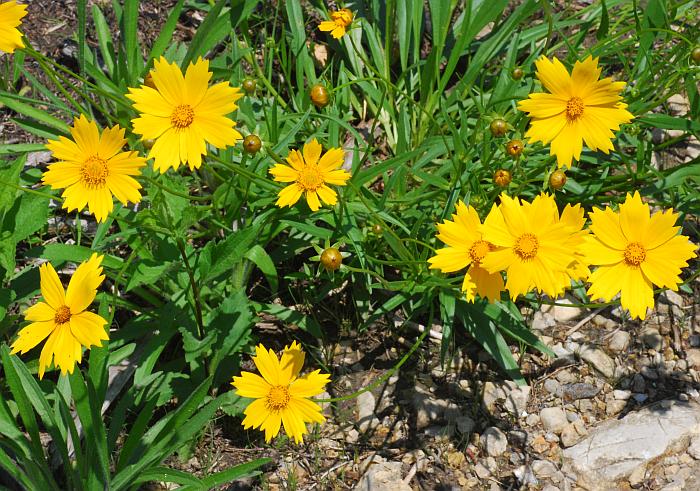Coreopsis lanceolata L.
Tickseed Coreopsis

Native
CC = 5
CW = 5
MOC = 38
© SRTurner
Coreopsis lanceolata L.Tickseed Coreopsis | |
 |
Native CC = 5 CW = 5 MOC = 38 |
© SRTurner |
|
Family - Asteraceae/Heliantheae Habit - Perennial forb, with a short, horizontal roostock. Stems - Erect or reclining, to 60 cm, often multiple from base, branching, glabrous to densely pubescent, hollow.
Leaves - Opposite, simple, entire, confined to usually 1-3 nodes in the lower half of the plant, the uppermost leaves sessile, the basal and lowermost stem leaves mostly long-petiolate. Leaf blades 2.5-12.0 cm long, narrowly oblanceolate to narrowly ovate, unlobed or with 1 or 2 deep basal (pinnate) lobes or divisions, in entire leaves the blade angled to long-tapered at the base, in divided leaves, the lateral lobes or divisions much shorter than the terminal lobe or division, 2-9 mm wide, linear, narrowly oblong, or elliptic, narrowed toward the base, angled or tapered to a usually sharply pointed tip, the surfaces glabrous or sparsely to moderately pubescent with short, spreading hairs.
Inflorescence - Usually solitary flower head terminating a long naked peduncle, this 8-40 cm long. Heads - Radiate, showy. Involucre cup-shaped, the bracts dimorphic, the outer series 5-10 mm long, glabrous, green; the inner series 9-12 mm long, green at base, yellow and translucent at apex. Chaffy bracts narrowly triangular, long-tapered from an abruptly broadened, flat basal portion to a sharply pointed tip. Receptacle convex.
Ray flowers - Sterile, usually 8, the corollas 15-30 mm long, with 3-5 deep, sometimes irregular or jagged teeth or lobes around the tip, uniformly yellow. Disk flowers - Perfect, 40-80 per head, the corollas 3.5-5.0 mm long, 5-lobed, yellow, sometimes with yellowish orange lobes. Style branches tapered abruptly to a sharply pointed, sterile tip. Pappus of 1 or 2 scalelike teeth 0.3-0.8 mm long.
Fruits - Achenes 2.5-4.0 mm long, the base and tip appearing curled or arched inward at maturity, the angles with broad, pale wings having entire or somewhat irregular margins, the inner face with a bulbous thickening at 1 or both ends, dark brown to black, 1 or both surfaces with numerous small, lighter-colored tubercles. Flowering - April - July. Habitat - Rocky prairies, glades, bluffs, roadsides, railroads. Origin - Native to U.S. Lookalikes - Other species of Coreopsis; more broadly, some species of Bidens, Helianthus, etc. Other info. - This species can be found in Missouri mainly in the Ozark Border Division, though it is also widely cultivated and sometimes seeded along roadsides. It occurs sporadically across most of the U.S. though it is most common in the eastern half of the country. As a group, Coreopsis are easily recognized by the showy yellow flower heads (often having characteristically lobed ray ligules) and strongly dimorphic involucres. C. lanceolata is identified by having only a few leaf nodes, which are restricted to the lower half of the plant. Note that plant hairiness is highly variable. The hairy and glabrous stem and leaf photos above were taken of plants within exactly the same population. Although Steyermark recognized different varieties based on pubescence characters, later studies have indicated that these differences were not meaningful. Photographs taken in Alley Spring Park, Shannon County, MO., 5-22-03, and off Hwy 21, Reynolds County, MO., 5-18-03 (DETenaglia); also at Shaw Nature Reserve, Franklin County, MO, 5-12-2007, 5-29-2007, 5-20-2008, 5-19-2009, and Washington State Park, Washington County, MO, 5-13-2015 (SRTurner). |